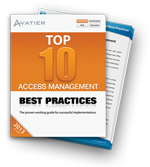I recently read the Better Business Bureau Names "BBB Top Ten Scams of 2013” and I thought to myself if such a distinction existed for B2B software and services, it would have to go to cloud identity management companies. To better clarify, it should go to cloud identity management companies who add new costs and increment existing costs by promoting simplicity and transparency. If you believe everything you read, you would assume the two options available to IT are to duplicate and manage identities individually on an app-by-app basis in the cloud or implement a complex difficult to maintain enterprise federated security system. Fortunately, a more cost effective agile and lean cloud identity management alternative exists.
In case you are curious as to the winner, scammers used the Affordable Care Act ("Obamacare") to convince people they needed new insurance, volunteer their personal information, and handover credit card account, social security and bank routing numbers. In most successful scams, fear plays an important role. Similarly, cloud identity management companies use the growing number of SaaS platforms, BYOD in the workplace, and password management complexity to instill fear in convincing organizations of heightened risks in managing identities in the cloud.
Let’s be clear. The problem is not in the management of identities in the cloud. The problem stems from duplicating identities in the cloud to enable workflow. For most enterprises, they are already fully equipped to leverage their corporate directory infrastructure in the management of identities across SaaS, PaaS and the myriad of cloud services without adding an IDaaS, Identity as a Service. The additional layer of complexity, the new costs, and the duplication of identities in the cloud required to enable workflow do not deliver enterprise value. On the contrary, they increase your bottom line and make your organization more vulnerable while adding complexity.
Somehow in stating the value of cloud identity management, the business problems needing to be solved get foggy. In today’s business environments, IT must address three challenges related to managing identities in the cloud none of which are insurmountable by any means.
- Fast onboarding of new SaaS applications
- BYOD access management with governance
- Smart migration from on premises systems to cloud apps
Fast Onboarding of New SaaS Applications
Without question SaaS and cloud services are growing in the workplace and the trend will continue as the next generation of legacy IT systems migrate to a technology as a service world. Gartner predicts global SaaS spending to exceed $22 billion by 2015. For IT the focus has changed from whether or not to migrate to a cloud service to how to immediately extend your infrastructure and leverage a new system.
Enterprises with an existing LDAP, Active Directory and web services infrastructure inherently possess the capabilities for configurable workflow and the management of identities in the cloud. Onboarding, integration, and managing access to a new SaaS should not present a holdup. It is simply another system to manage.
BYOD access management with governance
Gartner also predicts by 2017 half of employers will stop providing equipment to employees. The benefits of reducing and avoiding some costs altogether make BYOD integral to business operations. Concurrently, the practice of BYOD increases the number of mobile applications in the workplace. Organizations 2,500 to 5,000 employees expect to save between $500 million to $5 billion in revenue.
Similarly, enterprises can also manage web access through single sign-on and the automated provisioning of user account privileges without adding an IDaaS layer of complexity. Managing SaaS identities, access and sign-on should not require the replication and synchronization of identities with a third party. BYOD with SSO represents an opportunity to save. It should not add new costs.
Smart migration from on premises systems to cloud apps
Migration to a cloud service from your identity management solution should not be daunting or underestimated. To realize the benefits of cloud services, start with your applications slated for upgrades within the next twelve to eighteen months. From this list, determine the applications best suited for the cloud. Perform due diligence in selecting a SaaS similar to a RFP, but make it more like a proof of concept in your live environment or an enterprise sandbox.
Any solution that forces you to manage identities in multiple places should be avoided. The replication and synchronization of identities in the cloud creates new costs, increases the risk of bad data, and inserts latency between systems. Such solutions make provisioning workflow more complex and less dependable. An enterprise taking a flexible hybrid approach that moves an organization overtime from on-premise systems to the cloud can avoid unnecessary costs, prevent creating additional risks, and receive optimum value from their corporate infrastructure and SaaS investments.
 Get a Free Copy of the Top 10 Access Management Best Practices Workbook
Get a Free Copy of the Top 10 Access Management Best Practices Workbook
Begin your identity and access management initiative by following expert recommends for business process workflow automation, self-service administration and IT security.




